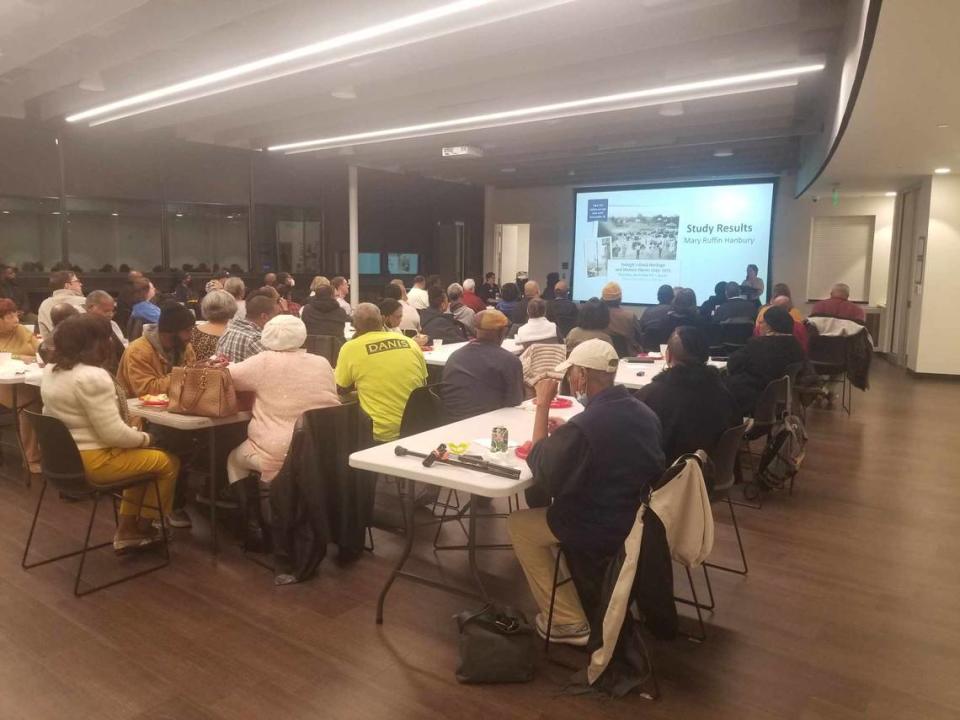Raleigh wants to protect its historic Black places before they disappear
If you learned a one-story, gable-roofed church tucked into a neighborhood for decades used to be a school, would that make the building worth preserving?
What if it was built by its African-American parishioners?
What if you learned it was home to a displaced congregation, forced to move out of its original building to make way for urban renewal projects?
That’s the story of Piney Grove AME Church, one of about 20 churches included in a draft study of Raleigh’s Black Heritage and Historic Places. The city is seeking feedback on the study, which will recommend places to add to the National Register of Historic Places.
“The more you know, the better decisions you make,” study author Mary Ruffin Hanbury said. “They may not be decisions I agree with all the time, but at least they’re not ignorant. They’re informed decisions.”
“I want everyone to embrace preservation ... but not everybody’s going to agree with me,” she said. “At least if I can give them the information, they’re not saying ‘Oh God, I didn’t know. I’m so sorry. We ripped it down.’”
What’s being studied?
The study specifically looks at historic places from 1945 to 1975 in Raleigh, emphasizing:
entertainment venues
places associated with the Civil Rights Movement
properties designed or built by African-American architects and building professionals
Biltmore Hills neighborhood.
Krystal Glenn attended a recent community meeting about the study. She inherited the house she grew up in, her mother’s Biltmore Hills home. She’s moving back into the home and recently bought the house next to her mother’s.
“The older houses are built differently,” she said. “I like the old ranch-style house. I like that you get a quarter-acre of land. Like my house where I stay has like 0.16 acres. It makes a difference.”
John Winters Sr., the first Black man to be elected to the Raleigh City Council, helped create the Biltmore Hills and Cedarwood Country Estates neighborhoods as a developer and builder.
“There were some major contributions that people are still benefiting from,” Glenn said. “The neighborhoods are still here, and the buildings are still holding up. The houses are, you know, good homes. And I think people need to acknowledge and recognize those contributions.”
In addition to individual sites, like churches across the city, the list includes two neighborhoods: Biltmore Hills and Cedarwood Country Estates. It also includes the Lincoln Theatre, a former movie theater serving mostly Black people during segregation, as an entertainment venue.
The study didn’t look at places already on the National Register of Historic Places or that have been the focus of previous studies.
Why does it matter?
Raleigh continues to face development pressure that sometimes pits growth against preservation.
“I would hope that preservation can be used as a tool to save and protect the best of what we have,” Hanbury said. “And it depends on a lot of things. It depends on political will. It depends on elected officials. It depends on public policy. It depends on the private sector. There are a lot of people that need to embrace this and say this is important.”
Many of Raleigh’s African-American historic places are already gone, some torn down for redevelopment and others through deliberate efforts of urban renewal programs.
“That’s not uncommon across the country,” Hanbury said. “But when you start looking at what used to be in your own town — which, again, if you’re not from there, you don’t remember it — and instead of seeing what’s there, you see what’s gone, it’s a little sad. It’s a little sad.”
The N.C. NAACP held the first statewide meeting at First Congregational Church, located at South and Manley streets. Urban renewal projects demolished the church and other parts of Fourth Ward neighborhood in the 1970s.
Jarod Ollison moved into his grandparent’s Cedarwood home and attended the recent meeting because he wants to make sure the house remains in his family.
“I’ve lived it for the last 40-something years, watching pieces of what I thought were investments in our culture be wiped away systematically,” he said. “It really breaks my heart to see what we once had and the pride we have in those things that is slowly fading away.”

What happens next?
▪ People can comment on the report online at engage.raleighnc.gov/blackheritage until Dec. 15. The final report will be sent to the Raleigh Historic Development Commission and then to the Raleigh City Council in 2024.
▪ Properties identified in the report will be included in the formal study list submitted to the N.C. National Register Advisory Committee, which will then decide whether to submit nominations to the National Register of Historic Places.
▪ The city is also seeking other ways to celebrate historic areas or places and is looking at programs in Greensboro, Winston-Salem and outside the state that celebrate historic places without regulations.

